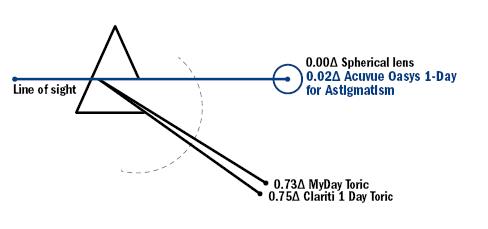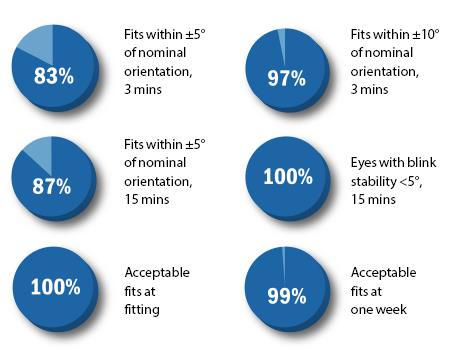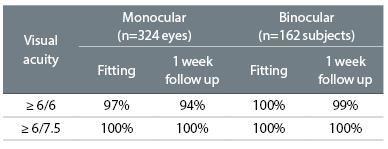unique technologies to deliver excellent comfort and clear,
stable vision, with a wide parameter range. Benjamin Straker,
Giovanna Olivares, Anna Sulley and David Ruston report
Many of our astigmatic patients find that current contact lenses are not providing the experience they would hope for or expect. Nearly six in 10 existing toric soft contact lens wearers (58%) report declining lens performance over the course of a day, a similar experience to spherical lens wearers.1,2
Toric wearers who undertake a variety of activities, shift between environments, and spend more time using digital devices during the day are more prone to declining lens performance.1 Those who experience a drop in performance report more diverse symptoms, feelings of tired eyes, dryness symptoms and visual compromise.1
Drop-out rates are also higher with toric soft lens wearers than among spherical lens wearers (27% vs 21% one year after fitting), and unsatisfactory vision and comfort are the most common reasons for those newly fitted with torics discontinuing.3
The case for torics
Leaving low astigmats uncorrected also delivers a sub-optimal experience. The proportion of soft lenses fitted that are toric has traditionally fallen short of levels expected from the prevalence of clinically relevant astigmatism in the population.4 Prescribing of daily disposable torics, in particular, has yet to reach its full potential with fewer prescribing options so far available compared with reusable torics.5
Yet the benefits of fitting toric lenses are clear. A high proportion of astigmats (94%) who are not using toric contact lenses can be successfully fitted.6 Previous dropouts and new wearers achieve visual acuity comparable to spectacles with soft torics, and spherical contact lens-wearing astigmats experience superior VA when refitted.
In fact, when low to moderate astigmats (-0.75 to -1.75DC) are fitted with soft torics, not only is visual performance improved but visual quality of life and satisfaction is also better than with spherical lenses.7 The National Eye Institute Refractive Error Quality of Life-42 (NEI-RQL-42) is a validated patient-reported outcomes questionnaire developed to assess the impact of refractive correction on vision-specific quality of life. This survey consists of 42 items used to develop 13 subscales: clarity of vision, expectations, near vision, far vision, diurnal fluctuations, activity limitations, glare, symptoms, dependence on correction, worry, suboptimal correction, appearance, and satisfaction with correction. The study findings reinforce the message that even low levels of astigmatic correction require a toric lens and that astigmatism cannot be masked with spherical or aspheric designs.8,9
Major opportunity
Understanding the situation of our astigmatic patients identifies a major opportunity to improve their contact lens wearing experience and ensures that even low astigmats have the chance to try toric lenses rather than be less than fully corrected.
Although toric designs and availability have improved in recent years,10 eye care practitioners still have some concerns when it comes to recommending and fitting toric lenses in practice. The most commonly cited issue is having only limited parameters available, followed by achieving stable vision and comfort, and first-fit success is also an issue.11
A lens that addresses these concerns has the potential to make a very real difference to our astigmatic patients’ everyday experiences and to increase the uptake of toric lenses in practice.
Meeting the challenge
The Acuvue Oasys Brand Contact Lens family is designed specifically to help support a stable tear film for exceptional comfort and performance in challenging environments.12
Eye-Inspired Design – applying an understanding of the natural eye to guide the development of new products – has provided two key technologies to meet these challenges and satisfy patient needs. These unique technologies have now been combined in the new Acuvue Oasys Brand Contact lenses 1-Day with HydraLuxe Technology for Astigmatism:
- HydraLuxe Technology used in spherical Acuvue Oasys Brand Contact Lenses 1-Day for exceptional tear film stability.13
- Eyelid Stabilised design (previously known as ‘Accelerated Stabilisation Design’) to provide exceptional visual stability.14,15
The lens also has the widest parameter range of any daily disposable lens for astigmatism on the market16 – in fact at least 40% more parameters – to bring these benefits to even more of our astigmatic patients.
A stable tear film
The lens uses a concept – Tear Infused Design – first introduced with the spherical Acuvue Oasys Brand 1-Day with HydraLuxe Technology lens, and inspired by the structure and function of the tear film.17,18
Building upon the senofilcon A silicone hydrogel used in Acuvue Oasys Brand contact lenses, HydraLuxe Technology comprises an enhanced moisture network of tear-like molecules plus a highly breathable hydrated silicone that integrates with the patient’s own tear film.18
Increased crosslinking reduces the muco-adhesiveness of the lens,19 helping the material to better mimic the function of the eye’s own mucins. Distributed evenly throughout the enhanced moisture network is the wetting agent polyvinylpyrrolidone (PVP), a tear-like molecule with a specifically formulated high molecular weight chain length to further mimic the properties of mucins.13
The continuous lubrication and moisturisation made possible by precisely formulated PVP, combined with the daily disposable modality, allows the Acuvue Oasys 1-Day material to help keep patients comfortable throughout their demanding days and avoid the feeling of tired eyes.18
This technology has helped deliver excellent comfort with Acuvue Oasys 1-Day overall, while working on a computer, from activity to activity and throughout the day.18 Of those who expressed a preference, patients preferred Acuvue Oasys 1-Day to Dailies Total1 by a ratio of 2:1. Comfortable wearing time for Acuvue Oasys 1-Day was also nearly one hour longer, at 14.1 hours versus 13.3 hours.
Existing toric wearers most prone to declining lens performance are those who experience more activities (≥8) or more environments (≥3) during the day, and the rate of decline correlates with intensity of digital device use.1 ‘Decliners’ also report more variety of symptoms (≥3) than those who maintain comfort over the course of the day, and the most commonly reported are tired eyes (74%), dryness (74%) and visual compromise (48%).
Acuvue Oasys 1-Day with HydraLuxe Technology for Astigmatism would therefore be a natural choice for astigmats with demanding days who would also appreciate the simplicity and ease of use of a daily disposable lens.
Clear, stable vision
The simplest of daily activities can produce a diverse range of frequent eye movements with the potential to destabilise a toric contact lens. Wearers may also experience up to 30° lens rotation when changing head position with some toric lens designs.14 The most common compensating behaviours patients use to deal with toric performance issues are rubbing their eyes and blinking hard to clear their vision.1
Eyelid Stabilised design is used in all Acuvue Brand lenses for Astigmatism. This ‘Eye-Inspired Design’ is different from other toric stabilisation techniques such as prism and peri-ballast approaches (see table 1).

Table 1: Features of eyelid stabilised design compared with prism-ballast and peri-ballast designs
Eyelid Stabilised design works with the natural movements of the eyelids during blinking, to orientate very quickly and to maintain stable orientation with eye and head movements. The thinnest parts of the peripheral lens geometry sit underneath the eyelids, thereby reducing the potential for unwanted interactions and discomfort.
The balanced, symmetrical nature of the design, with its four stabilisation zones, is an important feature. Because of its symmetry, the lens cannot be inserted ‘upside-down’ on the eye, and the maximum amount it can be inserted off axis is half that of a prism-ballast design (90° vs 180°).
The symmetry of Eyelid Stabilised design also confers an advantage in terms of minimising unwanted prism in the optic zone. An independent laboratory measured the thickness of toric lenses over 2,000 data points for a range of powers (-6.00 to +3.00DS, axes 90° and 180° in -1.25DC) from various manufacturers.20 Published data on refractive index were then used to compute the vertical prism in the central 6mm of the optic zone for each design.
Except for Acuvue Oasys for Astigmatism, all other re-usable soft torics tested had significant vertical base-down prism within this central zone, ranging from 0.52∆ to 0.95∆. Unwanted vertical prism is an especially important consideration for the nearly half (47%) of all astigmats (≥0.75DC) who require a toric lens in one eye only.5
This work has since been repeated with Acuvue Oasys 1-Day with HydraLuxe Technology for Astigmatism and a similar value found (0.02Δ) (figure 1).22 Vertical phorias possibly caused by prism dissociation due to the presence of induced optical prism is a relevant factor for practitioners to consider when fitting toric contact lenses for monocular astigmats or those requiring a mix of toric soft contact lens designs. It should be noted that clinical studies have not been done to fully characterise the effects of differences in base-down prism among CLs.

Figure 1: Vertical prism in the optic zone of a range of daily disposable, toric contact lenses22
Several studies under real-world conditions have demonstrated the advantages of lenses utilising Eyelid Stabilised design for consistent, clear and stable vision.5
These lenses are more stable after insertion and during large versional eye movements,20 provide consistent visual performance in all gaze directions15 and show less rotation with head movement14 compared to prism-ballast designs evaluated. In the recumbent position, the lenses rotate less than prism-ballast designs,23 and show significantly less mis-orientation and better monocular visual performance.24
Playing sport, looking in the rear-view mirror when driving or watching television when lying down are just some of the everyday situations where rotational stability is especially important.
With this proven design, Acuvue Oasys 1-Day with HydraLuxe Technology for Astigmatism offers major advantages over other design approaches.
On-eye performance
Combining these two technologies has the potential to deliver real benefits to patients and to practitioners. So how does the lens perform in clinical practice?
A subject-masked, two-visit, bilateral wear, one-week dispensing study of 162 habitual toric soft lens wearers was conducted in the US.25 Both eyes had prescriptions with a spherical distance refraction of -1.50 to -4.00D, cylinder of -0.75 to -1.50DC, and cylinder axis within 180±15° or 90±15° to coincide with the parameters available at the time the study was carried out.
Results are summarised in figure 2. The first results are at three minutes after insertion. ‘Nominal orientation’ refers to the toric lens markings being exactly vertical (ie at the 12 and six o’clock positions). After just three minutes following insertion, almost all lenses (97%) settled within 10°, and more than eight out of 10 (83%) were within 5° of nominal orientation.

Figure 2: Summary of clinical performance results (n=324 eyes)
By 15 minutes, the proportion of lenses within 5° had increased to nearly nine out of 10 (87%) and stability on blink – a key factor in providing stable vision – was at 100%. That is, all 324 eyes showed less than 5° movement on blink at 15 mins, giving a stable and predictable fit, as well as minimising chair time.
All 324 eyes had an acceptable fit at fitting. Only one lens needed to be refitted because of mis-orientation, and another two due to spherical power adjustment, resulting in a 99% first-lens-fit success rate. And at one week, 321 of the 324 eyes, 99% of all eyes fitted continued to show an acceptable fit, demonstrating the consistency and stability of this lens design.
Visual acuity was also excellent; all patients achieved 6/7.5 or better monocularly, and 97% achieved 6/6 or better (figure 3).

Figure 3: Visual acuity results at fitting (n=162)
Patients’ responses to the lenses reflect these clinical findings (figure 4). More than eight out of 10 patients (83%) rated clarity of vision with the lenses during head movement as excellent or very good, and agreed strongly or somewhat that they provided consistent vision (85%).
Comfort was rated highly for all-day wear and from activity to activity. Remember that these are key areas that do not currently perform well for those existing toric lens wearers who experience a decline in performance throughout the day.1
Keeping shape while handling is an important enabler for patients to enjoy an easy experience when inserting their lenses. More than eight out of 10 patients (84%) rated the lens as either excellent or very good for this attribute.
Parameter range
The parameter range is designed to make fitting as easy as possible. All three cylinder powers, -0.75DC, -1.25DC and -1.75DC are available in axes around the clock for sphere powers plano to -6.00DS. For patients with higher astigmatism, an additional -2.25DC option is available in the most common meridians.
In total, 2,260 parameters are available, making it now the widest range available for toric soft daily disposable lenses.16
The new lens is available in an 8.5mm base curve and 14.3mm diameter. In addition to the technologies described, like its spherical counterpart, the lens incorporates Infinity Edge Design, Class 1 UV blocking and an optimised packaging solution.
The Acuvue Oasys 1-Day family now provides coverage for nearly 96% of spherical and astigmatic eyes, with the toric option alone providing correction for 87% of astigmatic eyes.
The addition of Acuvue Oasys 1-Day with HydraLuxe Technology for Astigmatism, with its unique combination of technologies, will allow even more of your patients with challenging days and challenging environments to improve their contact lens experience, and deliver significant advantages to you and your practice too.
Key points
- Acuvue Oasys 1-Day with HydraLuxe Technology for Astigmatism is a new daily disposable toric lens for patients with challenging days.
- Toric wearers who experience more activities and environments per day, or who suffer declining comfort with their lenses through their busy day, are ideal candidates for this lens.
- The lens incorporates a unique combination of technologies for exceptional tear film and visual stability.
- On-eye performance shows fast, predictable and consistent orientation with a first-fit success rate of 99%.
- The lens is available in 2,260 parameters, at least 40% more than any other daily disposable toric contact lens.
Benjamin Straker is principal research optometrist, Dr Giovanna Olivares is astigmatism platform director, Research and Development, Anna Sulley is associate director for global medical affairs and David Ruston is director global professional affairs for Johnson & Johnson Vision.
References
1 Mathews K, Daigle B and Olivares G. Understanding the astigmat’s toric soft lens experience. Optician 2017;253: 6600: 32-35.
2 Mathews K, Daigle B, Alford et al. Exploring variability in soft contact lens performance. Optician 2016; 251:6546 32-34.
3 Sulley A, Young G, Hunt C et al. Factors in the success of new contact lens wearers. Cont Lens Anterior Eye 2017; 40:1 15-24.
4 Young G, Sulley A and Hunt C. Prevalence of astigmatism in relation to soft contact lens usage. Eye Contact Lens 2011; 37: 20-25.
5 Sulley A. Turning to torics: an update on soft toric contact lenses. Optometry Today; 30 May 2015: 40-45.
6 Sulley A, Young G, Lorenz KO et al. Clinical evaluation of fitting toric soft lenses to current non-users. Ophthal Physiol Opt 2013; 33:2 94-103.
7 Nichols J, Berntsen D, Bickle K et al. A comparison of toric and spherical soft contact lenses on visual quality of life and ease of fitting in astigmatic patients. Paper presentation at Nederlands Contactlens Congres, March 2016.
8 Bernstein PR, Gundel RE and Rosen JS. Masking corneal toricity with hydrogels: does it work? Int Contact Lens Clinic 1991;18: 67-70.
9 Morgan PB, Efron SE, Efron N et al. Inefficacy of aspheric soft contact lenses for the correction of low levels of astigmatism. Optom Vis Sci 2005; 82:9 823-8.
10 Edrington TB. A literature review: the impact of rotational stabilisation methods on toric soft contact lens performance. Cont Lens Anterior Eye 2011; 34:3 104-110.
11 J&JV data on file, 2014. Kadence International, Astigmatic prescribing behaviour study (n=586) in 4 countries (US, Japan, Russia, South Korea). ECP response to the question ‘List your top three challenges with prescribing toric CLs’.
12 Meyler J, Pall B and Todd S. Changing the conversation. Optician 2017; 253:6584 26-29.
13 J&JV data on file, 2015. HydraLuxe Technology Definition.
14 McIlraith R, Young G and Hunt C. Toric lens orientation and visual acuity in non-standard conditions. Cont Lens Anterior Eye 2010; 33:1 23-6.
15 Chamberlain P, Morgan PB, Moody KJ et al. Fluctuation in visual acuity during soft toric contact lens wear. Optom Vis Sci 2011; 88:534-538.
16 J&JV Data on file 2017. Proportion astigmats accommodated with Acuvue Brand CLs for Astigmatism.
17 Johnson B, Pall B and Scales C. Inspired by the science of tears. Optician 2016; 251:6551 32-34.
18 McParland M, Pall B and Schnider C. New lens for demanding days. Optician 2016; 251:6555 24-28.
19 Park H and Robinson JR. Mechanisms of mucoadhesion of poly(acrylic acid) hydrogels. Pharmaceutical Research 1987; 4:6 457-464.
20 Zikos GA, Kang SS, Ciuffreda KJ et al. Rotational stability of toric soft contact lenses during natural viewing conditions. Optom Vis Sci 2007; 84:11 1039-45
21 Sulley A, Hawke R, Osborn Lorenz K et al. Resultant vertical prism in toric soft contact lenses. Cont Lens Anterior Eye 2015; 38:4 253-7.
22 J&JV data on file, 2016. Design features and performance of Acuvue Oasys Brand Contact Lenses 1-Day with HydraLuxe Technology for Astigmatism.
23 Young G, McIlraith R and Hunt C. Clinical evaluation of factors affecting soft toric lens orientation. Optom Vis Sci 2009; 86:11 E1259-66.
24 Hall LA, Osborn-Lorenz K, Sulley A et al. Effect of head and gaze position on toric soft contact lens performance. Presentation at British Contact Lens Association Clinical Conference 2014.
25 Straker B, Hamada W, Sulley A et al. Fitting performance and efficiency with a new silicone hydrogel daily disposable toric contact lens. Poster presentation at Global Specialty Lens Conference, January 2017.
